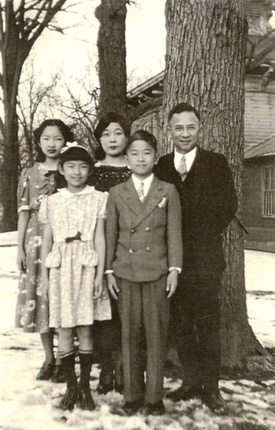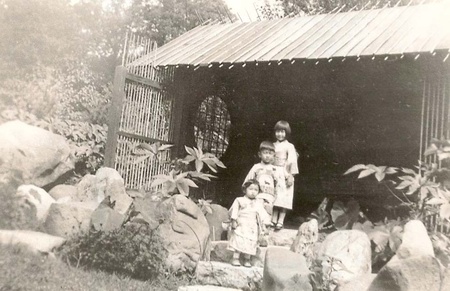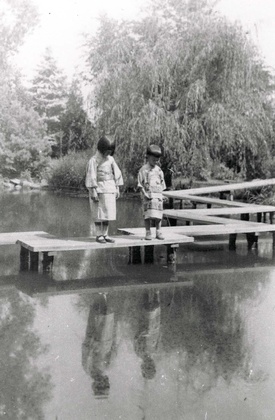After Taro Otsuka left Riverbank, another Japanese gardener named Oscar Susumu Kobayashi took over maintaining the garden Otsuka had built for George Fabyan around 1910. Kobayashi had met Otsuka at the Japanese YMCA in Chicago around 1917,1 when he was there looking for a job. In the years that followed, Otsuka and Kobayashi were close enough that Kobayashi let Otsuka stay at his place in Florida for several weeks in the winter of 1923-24, when Otsuka did not have much to do in Chicago.2
Kobayashi was born in Shimane in March 1892 and arrived in Seattle at age twenty-two in February 1914, with his final destination being the Yamato Colony, a Japanese agricultural community in Boca Raton, Florida.3 Kobayashi knew about this colony because his brother-in-law's sister was an in-law of Yuzuru Sakai, the founder of the colony.4
Three years later, Kobayashi went from Florida to Detroit, Michigan “to enter a work-study program at the Ford Motor Company in Detroit so that he could go back to Japan and set up an automobile factory there.”5 But when the U.S. entered World War I, Ford ended the program and Kobayashi went to Chicago and the JYMCI to look for work. At this point, Taro Otsuka introduced him to the domestic work available at Riverbank.

According to Sumiko Kobayashi, “After a brief fling at an egg and squab business, Kobayashi was offered work once more at Riverbank.”6 He returned to Illinois in 1925 with his family, lived at 85 Kaneville Road in Geneva,7 and for the next fourteen years worked at Riverbank as houseman, gardener, and manager of five greenhouses, which supplied cut flowers daily to Chicago and local markets. “The greenhouse operation was highly successful” and one year a rose from the Riverbank greenhouse managed by Kobayashi "won first prize at a flower show."8 During the Kobayashi’s fourteen years at Riverbank, their first son, Noboru, and second daughter, Michiko, were born in September 1926 and October 1929 respectively.
According to Sumiko Kobayashi, who grew up at Riverbank from ages two to sixteen, she “spent a delightful childhood at Riverbank. It was a wonderful place to roam, explore and sometimes get into mischief.” To Sumiko, George Fabyan “looked somewhat like Ernest Hemingway with his white hair and beard”9and she remembered very well how she had played with the other children of Riverbank employees. According to Sumiko, the work force at Riverbank was “a veritable United Nations” consisting of “immigrant Norwegians, Swedes, French-Canadians, Japanese, Russian, Czechoslovakians and Scottish.”10 It was reported that about a hundred employees were on staff to take care of the grounds, care for the animals, which included horses, bears, monkeys, parrots and alligators, and to work on other projects for Fabyan.11
Riverbank was also where Sumiko learned how to swim. She recalls that one day while he was strolling throughout the estate, George Fabyan noticed that Sumiko was the only child stuck in the shallow end, not venturing into the deep water in a spring-fed Roman-style swimming pool on an island in the Fox River. “Convinced he knew the best way to teach her to swim, Fabyan ordered Sumiko to jump off the diving board. The petrified girl begged, but Fabyan barked out his order more loudly. She eventually jumped, promptly panicked, and began to sink. Others rushed in to save the young girl from drowning while the oblivious Fabyan continued on his rounds.”12 However, George Fabyan remained in her mind as a fond memory. Sumiko chuckled when she told the author in a phone interview that Fabyan gave a dime to every child he came across.
“Although the employees’ families and the Fabyans didn’t socialize, each Christmas the children would receive beautifully wrapped gifts from the Fabyans.”13 Sumiko emphasized that Riverbank was a great place to grow up and that she was well-accepted, experiencing no discrimination at school although she was the only Japanese, because she did well and her father worked for Fabyan. She remembered that her brother, Noboru, learned how to fold the U.S. flag properly in a triangle, and helped his father raise it high every morning and take it down every evening. Sumiko also had good memories of cutting ice on the Fox River for cold storage.
The Kobayashis only went to Chicago four or five times a year, and the main place for them to gather with other Japanese in Chicago was the JYMCI, where Kobayashi had met Taro Otsuka. Their family friends were Junji Matsumoto and his daughters, Kiku and Mary, who were neighbors in Geneva, Illinois.
Junji George Matsumoto
When George Fabyan died in 1936, his resident cook retired and Kobayashi recommended Junji Matsumoto for the position of cook at Riverbank. It was at the JYMCI that Kobayashi had met Matsumoto, an experienced cook who had worked at the JYMCI off and on.14 Matsumoto was born in October 1880 in Wakayama15 and had come to San Francisco in 1896 or 1897. He worked as a house servant in San Francisco, worked for a sorority at Stanford University, and was a chef for army officers at military bases at The Presidio and in Monterey.16 After the 1906 San Francisco earthquake, he went to Indianapolis in 1908 and worked as a chef.17 In 1910 he was listed as a cook at a hospital in Gary, Indiana18 and as a chef at the Interlaken School in La Porte, Indiana.19 During World War I, he served in the military as a cook20 and in the 1920s he worked as a cook at the U.S. Steel hospital in Gary, Indiana.21
Matsumoto married a Russian woman named Mary22 in Chicago in January 1912.23 Their first daughter, also named Mary, was born in Gary, Indiana and their second daughter, Kiku, was born in La Porte, Indiana. Matsumoto kept moving and worked as a chef in Indiana, Michigan and Florida, but he lost his wife in La Porte during a typhoid epidemic some time around 1930.24 In 1936 or 1937, Matsumoto joined the staff at Riverbank as a cook and remained there until the death of Nelle Fabyan, George’s wife, in 1939.
In November 1939, after Riverbank’s original owners were gone, the Kobayashis left Illinois for San Leandro, California, with no idea of what was waiting for them, as anti-Japanese sentiment was coming to a head. Matsumoto stayed in Chicago with his daughters and opened his own restaurant at 644 E 63rd Street, and his daughter, Mary, worked as its manager.25 Unfortunately, the restaurant was not successful. Junji Matsumoto died in Chicago in 1951 and was buried in La Porte, Indiana next to his wife.26
The 1940 census still reported thirty-four Japanese domestic workers in Chicago: thirty males and four females, or about 14 %of the 220 adult Japanese men and 5% of the eighty-three adult Japanese women.
According to scholar Yuji Ichioka, “school boys” on the West Coast had a difficult time adapting domestic service in the U.S. because they felt low self-esteem working jobs that were usually held by lower-class women in Japan. They also lacked knowledge of American customs and practices, and due to the language gap, had difficulty understanding their employers' orders.27 On the other hand, their American bosses complained a lot about the “school boys” and called them untrustworthy.28 There was some concern that the “school boys” reputations might hurt Japan's national image and lead to anti-Japanese immigration laws, like the Exclusion Acts targeting the Chinese.29
Similarly in Chicago, “school boys” were not commonly accepted and Japanese students supported themselves by working weekends in places like Chinese restaurants.30 Domestic work in Chicago was usually performed by poor immigrant women of Irish, German, Scandinavian, Polish, and later, African American women.31 Community activist Tamezo Takimoto was alarmed by the increasing demand for and popularity of Japanese male domestic servants. His concern was not only that Japanese would be stereotyped as domestic servants, but that Japanese domestic servants were enjoying somewhat luxurious lives, spending 80-90% of their pay on entertainment, with no concept of saving for the future.32 Takimoto declared that he did not care if as many as 1000 Japanese domestic servants lived in Chicago, as long as they saved some of their earnings to grow into capital assets, which might contribute to the welfare of Chicago's Japanese community.
According to Takimoto, the Japanese in Chicago were very independent-minded, with no sense of hierarchy or community-mindedness.33 This trait might have helped those who were employed as domestic servants to enjoy life, because, to some extent, domestic work had a “personalized, decentralized nature.”34
No matter where they were, on the West Coast or in the Midwest or elsewhere in the United States, there is no doubt that these domestic workers “laid the initial foundations of Japanese immigrant society”35 and played an important part in Japanese American history in America.
Notes:
1. Sumiko Kobayashi’s letter to Darlene Larson, dated September 6, 1976, Preservation Partners of the Fox Valley.
2. Ibid.
3. Washington arriving and departing passenger and crew list.
4. Kawai, Ryusuke, Yamato Coroni: Furorida ni “Nihon” wo nokoshita otoko-tachi, page 91.
5. Sumiko Kobayashi’s memoir, Susumu Kobayashi, January 1, 1976, Sumiko Kobayashi Papers, MSS71, Historical Society of Pennsylvania.
6. Ibid.
7. 1930 census.
8. Sumiko Kobayashi’s memoir.
9. Sumiko Kobayashi’s memoir, Riverbank, January 1, 1976.
10. Ibid.
11. Kane Country Chronicle, June 5, 1991.
12. Munson, pages 6-7.
13. Kane Country Chronicle, June 5, 1991.
14. Sumiko Kobayashi Papers, MSS 073A Box1, Folder7, Historical Society of Pennsylvania.
15. WWII registration.
16. Sumiko Kobayashi Papers.
17. 1908 Indianapolis City Directory.
18. 1910 census.
19. WWI Registration.
20. Eizo Yanagi File RG 60 General Records of the Department of Justice WWII Alien Enemy Internment Case Files 1941-1951, Box 255, National Archives and Records Administration, College Park, Maryland.
21. 1925 & 1927 Gary City Directory.
22. Indiana Death Index, for Junji Matsumoto.
23. Cook County Illinois marriage Index.
24. Sumiko Kobayashi Papers.
25. WWII Registration, 1940 census for Mary Matsumoto.
26. Sumiko Kobayashi Papers.
27. Ichioka, Yuji, The Issei, page 24.
28. New York Shimpo, February 22, 1913.
29. Ichioka, page 24.
30. Chicago NY Shimpo January 11, 1913.
31. The Encyclopedia of Chicago, page 242-243.
32. Chicago NY Shimpo, February 15, 1913, March 1, 1913.
33. Chicago NY Shimpo, January 4 and March 1, 1913.
34. The Encyclopedia of Chicago, page 242-243.
35. Ichioka, page 28.
© 2022 Takako Day








